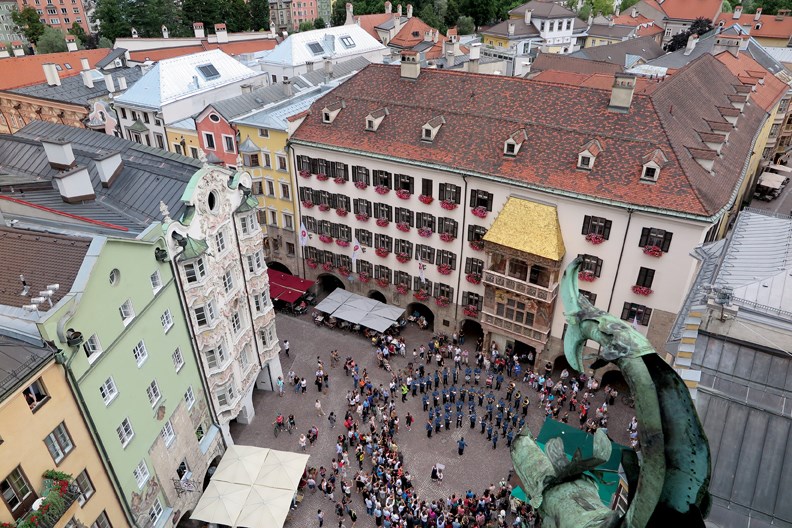Sitting in the Golden Hall of the Hohensalzburg Castle and listening to the ensemble’s spirited live performance of Haydn, Mozart and Strauss, I gazed out the open window at the City of Salzburg and the Salzach River below and occasionally looked up at the hall’s ceiling with its 3,000 gilded bosses that resembled the stars of the night sky, and was overjoyed to be in such a city of music. I vowed to take in Mozart’s birthplace at Getreidegasse 9, now a museum in the Old Town, to pay my respects.
I had flown Vancouver to Frankfurt to Salzburg and was staying at the Hotel Auersperg, which was only a short walk down the pedestrianized Linzergasse from the Old Town. I had bought my concert ticket online, and it included the round-trip ride on the glass funicular to the cliff-top, 900-year-old castle. Famous for The Sound of Music, Salzburg offers bicycle and coach tours to sites from the film and even a Marionette Theatre show, but I was content to just see the cast in the castle’s Marionette Museum.
Not to be missed are the Salzburg Cathedral, the famous Residenzbrunnen (marble fountain) at the Old Town Baroque square, the subterranean Domgrabungsmuseum with its Roman mosaics, and the Salzburg Museum. An added treat was the weekly Schrannenmarkt, a farmers’ market where locals gather to buy fresh fruit, vegetables, meats, flowers and snacks from the region.
A fan of public transit, I took a 12-minute bus ride south of Salzburg to the Schloss Hellbrunn, a palace featuring extensive gardens and many trick fountains, the most elaborate an 18th century, water-powered mechanical theatre with 200 moving lime wood figures enacting everyday life in the city.
For dinner, I loved the Alter Fuchs (Old Fox) restaurant on Linzergasse, which was cozy-casual and served reasonably-priced local specialties in a traditional setting. I had my heart set on strudel at the Café Tomaselli, founded in 1700 and one of Mozart’s haunts, but I had to settle for the nearby outdoor Tomaselli Kiosk. With its tables spread out on the lawn, obviously designed to handle an overflow summer crowd, I thought the kiosk had just opened this summer. Imagine my surprise when I saw Theodor Ethofer’s painting, The Tomaselli Kiosk, in the Salzburg Museum. Painted in 1910, was that same kiosk, with similar guests and food, only the women’s dresses and hats were different.
From Salzburg, Inns-bruck is only a two-hour scenic train ride. My hotel in Innsbruck was the Weisses Kreuz, the same one that Mozart stayed in with his father Leopold in 1769. On the pedestrianized Herzog-Friedrichstrasse, my hotel was only a stone’s throw from the Golden Roof, the oriel window topped with 2,657 fire-gilt copper tiles, which has become the symbol of Innsbruck, capital of Austria’s Tyrol Province. Armed with a newly-purchased Innsbruck card, I set out to see as many sites as possible, only to be immediately waylaid by a free concert by a youth orchestra in full Tyrolean costume. In Innsbruck, it’s good to keep your eyes and ears open. For example, wandering the streets and alleys of the late-medieval Old Town, be sure to look up to see the many frescoes, paintings and reliefs on the walls of the buildings.
So take your time, but don’t miss the Imperial Palace, with its great hall rebuilt by Empress Maria Theresa in 1750 Late Baroque. A large mirror on wheels allows you to examine the high ceiling frescoes in detail. The Court Church features the empty sarcophagus of Emperor Maximilian I, guarded by 28 larger-than-life bronze statues, including one of King Arthur, designed by the German artist Albrecht Dürer. I noticed that an intimate part of the statue of Emperor Rudolf has evidently been much polished by visitors.
I was fascinated by the Tyrolean Regional Heritage Museum with its collection of wood-panelled German parlours, from the Gothic to rococo, with their low ceilings, carved chairs and ceramic tiled ovens. The museum had a modern exhibit featuring the many voices of present-day Austrians, notably those of the 21.6 per cent of the population with a migration background.
The 148 steps of the Innsbruck City Tower were worth the climb for the 360-degree view of the city. I was lucky enough to view and hear a full marching band as it moved through the streets below. The Grassmayr Bell Museum, whose owners have cast bells since 1599, was fascinating, and I bought a cow bell just like the ones I had heard in the Alps.
My favourite place in Innsbruck was St. James’ Cathedral with its early 16th-century Madonna by the German painter Lucas Cranach the Elder. The painting has been widely copied and is found throughout the Alps. You’ll see versions of it on many facades in the Old Town. My favourite place to eat was the Café Katzung with its outdoor as well as indoor tables within sight of the Golden Roof. The indoor seating proved a blessing when rain poured down during an unexpected evening thunder storm.
A funicular that connects the Old City with cable cars higher up lets you easily reach the local mountains with their scenic overlooks and hiking trails. The beauty of Austria for me is that it offered me cities and cultures as well as hikes across meadows and mountains.



